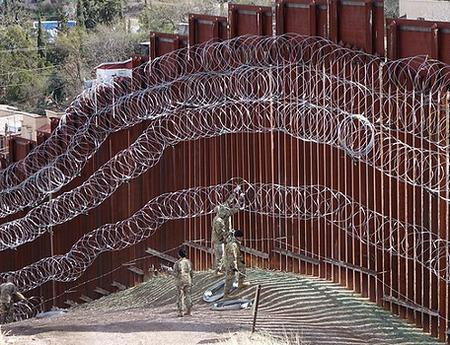
WASHINGTON, DC, February 11, 2021 (ENS) – A national emergency no longer exists at the U.S. southern border with Mexico; it has been terminated after nearly two years. On Wednesday, President Joe Biden issued a proclamation that ends the national emergency first declared by former President Donald Trump on February 15, 2019, and twice renewed.
“I have determined that the declaration of a national emergency at our southern border was unwarranted,” President Biden wrote in a letter to Congressional leaders, explaining his move.
The Biden Administration’s policy is “that no more American taxpayer dollars be diverted to construct a border wall, and that I am directing a careful review of all resources appropriated or redirected to that end,” he wrote to House Speaker Nancy Pelosi, a Democrat representing California, a state on the southern border.

“I hereby report to the Congress,” wrote Biden, “that the national emergency declared by Proclamation 9844, and continued on February 13, 2020, and January 15, 2021, is terminated and that the authorities invoked in that proclamation will no longer be used to construct a wall at the southern border.”
After losing fights with Congress over funding for the wall, Trump’s emergency declaration opened a path for him to divert funds originally intended for other agencies, such as the Department of Defense, to use on border wall construction. President Trump diverted $2.5 billion in military pay and pension funds for the border wall.
But the American Civil Liberties Union brought legal action against President Trump on behalf of the Sierra Club and Southern Border Communities Coalition. The district court in 2019 and the Ninth Circuit Court of Appeals in June 2020 ruled that President Trump’s attempt to circumvent Congress and transfer $2.5 billion in military pay and pension funds for border wall construction is unlawful.
The district court blocked the illegal wall construction, an order that the Ninth Circuit affirmed. Yet, the Supreme Court in July 2020 left in place an earlier order that permitted the Trump administration to temporarily continue construction of the border wall while the underlying legal challenge proceeded in the courts.
Now that President Biden has stopped construction of the wall, these legal actions are moot. But now conservationists and human rights advocates want whatever sections of the wall that were built to be deconstructed.
“Ending Trump’s sham emergency declaration is a good start, but just hitting the brakes isn’t enough. Trump’s wall devastated border communities, the environment, and tribal sites. It’s time for the Biden administration to step up for border communities, and commit to mitigating environmental damage and tearing down the wall,” Dror Ladin, a staff attorney with the ACLU’s National Security Project, told “The Hill” newspaper today.
Congressman Raul Grijalva, a Democrat, of the border state of Arizona says, “Trump declared the national emergency in 2019 to divert billions in congressionally-appropriated Defense Department funds to construct his border wall after Congress refused to provide him with the necessary funds.”
“Trump’s national emergency was never about security,” Grijalva said. “It was about stealing taxpayer dollars to build a monument to his racist policies while destroying environmental treasures, Native American sacred sites, and border communities in the process. The end of this fake emergency was a long time coming.”

“Now, the Biden Administration must immediately cancel the existing construction contracts to ensure that not another foot of border wall is constructed under his watch,” Grihalva demanded. “We have a duty to recognize the severe impacts border wall construction has had on border communities and begin our work to remedy the major damage caused by Trump’s destructive policies.”
On the other hand, Republican Senators are appealing to President Biden to reconsider due to the pandemic.
In a letter today, U.S. Senators Ted Cruz of Texas, Tom Cotton of Arkansas, John Barrasso of Wyoming, Marsha Blackburn of Tennessee, Joni Ernst of Iowa, Jim Inhofe and James Lankford of Oklahoma, Mike Lee of Utah, Marco Rubio and Rick Scott of Florida, John Thune of South Dakota, and Thom Tillis of North Carolina urged President Biden to reassess and reverse his executive actions on immigration, which they claim “have led to increased illegal border crossings by unvetted and unvaccinated aliens in the middle of a pandemic.”
“We are seeing reports of human smugglers increasing recruitment, and migrant caravans are again rushing toward the United States,” the Republican Senators wrote. “The immigration surge caused by your policies has even forced your administration to reopen a child immigration detention facility that Democrats called to close during the previous administration.”
“The increased arrival of illegal aliens into American communities also poses a health threat to the average citizen. To date, Mexico is estimated to have vaccinated less than one percent of its population and Northern Triangle nations have vaccinated virtually none of their citizens. The vast majority of illegal aliens come from these four, mostly-unvaccinated nations,” the Republicans wrote.
The Republican Senators compared the Biden administration’s enforcement of pandemic-related restrictions on air travel into the United States with the President’s actions at the southern border, which they describe as, “giving illegal aliens a free pass to enter the United States without testing.”
“There is no legitimate justification for your administration being more restrictive with American citizens traveling within our country than illegal aliens who are rushing across our borders. This is the beginning of what could rapidly turn into a public health and humanitarian disaster,” they wrote.
But on the other hand, the U.S. Government Accountability Office released a report in November 2020 detailing that as of July 2020 the federal government had seized 135 private tracts of land, a total of about 5,275 acres, and was trying to acquire 991 additional tracts of land for the border wall.
New Mexico Senator Martin Heinrich, a Democrat, is pleased with President Biden’s move. He remains “vehemently opposed to the funding and construction of the Trump administration’s border wall along the U.S.-Mexico border.”
Heinrich and former New Mexico Senator Tom Udall, now retired, both denounced Trump’s efforts to raid $125 million from New Mexico military construction projects, including $85 million from a project at Holloman Air Force Base and $40 million from a project at White Sands Missile Range to pay for the border wall.
To clarify the historical record, the Poynter Institute’s Politifact online project checks how factual statements by politicians prove to be. Then-President Trump’s assertion on the campaign trail in October 2020 that, “The wall is going to be finished very shortly, over 400 miles,” is wrong, says Politifact.
“Trump’s administration has mainly replaced barriers installed by previous administrations with new ones that are expected to be more effective in stopping illegal immigration and drug smuggling. He has not added hundreds of miles of wall to protect the border for the first time,” Politifact said.

Trump’s famous assertion that “Mexico is paying for the wall,” is also false, Politifact confirms. The construction that has gone up is being financed by American taxpayers.
The Trump administration has said that construction costs are covered by the U.S. departments of Homeland Security and Defense and from the Treasury Forfeiture Fund.
The nonprofit conservation group Center for Biological Diversity, which has its headquarters in the border state of Arizona, says border wall construction, “harms border communities, perpetuates human suffering, destroys thousands of acres of habitat, and threatens to halt the cross-border migration of dozens of animal species.
As revealed in the Center’s 2017 report “A Wall in the Wild,” 93 threatened, endangered and candidate species of wildlife are vulnerable to the construction of the wall and related infrastructure, including jaguars, Mexican gray wolves Peninsular bighorn sheep, and Quino checkerspot butterflies.
The Center declares on its website, “This is a tragedy for the region’s diverse wildlife and people, as well as its rugged and spectacular landscapes. We’re fighting in the courts, in Congress and in our communities to repair the damage done by this cynical attack on our beautiful borderlands. We won’t stop fighting until the wall is torn down.”
Walls and fences designed to secure national borders could make it difficult for almost 700 mammal species to adapt to climate change, new research demonstrates.
The study led by Durham University, UK, looks at how human-made barriers could restrict the movement of animals as they shift between countries to find the best places to live.
The researchers identified 32,000 kilometers (19,884 miles) of borders across the world that are fortified with fences and walls, which have the potential to stop large numbers of animals from moving to more suitable environments.
Of these barriers, the U.S.-Mexico border wall, fences along the border between China and Russia, and fencing being constructed along the India-Myanmar border might be the most ecologically damaging, the Durham researchers said.
The authors calculated that the U.S.-Mexico border wall alone could obstruct the movement of 122 mammal species displaced by climate change.
Copyright Environment News Service (ENS) 2021. All rights reserved.
© 2021, Environment News Service. All rights reserved. Content may be quoted only with proper attribution and a direct link to the original article. Full reproduction is prohibited.



